5.5 Creating a User Home Folder Policy
A policy in File Dynamics is the means by which the product provisions, manages, deletes, and archives storage. The parameters within an Identity-Driven policy dictate where user storage is created, what permissions are granted, what quota to assign, what to do when a user is deleted, and much more.
IMPORTANT:Only one Identity-Driven policy of the same type can be associated with a domain, organizational unit, group, or user.
-
In the Admin Client, click the Identity Driven tab.
-
Click Policies.
-
In the Manage menu, select New > User Home Folder.
The following dialog box appears:
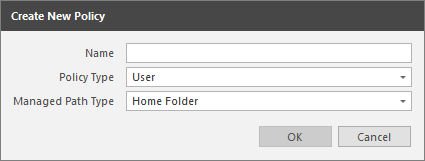
-
Specify a descriptive name for the policy, such as “Los Angeles Division,” then click OK.
The Policy Options page appears.
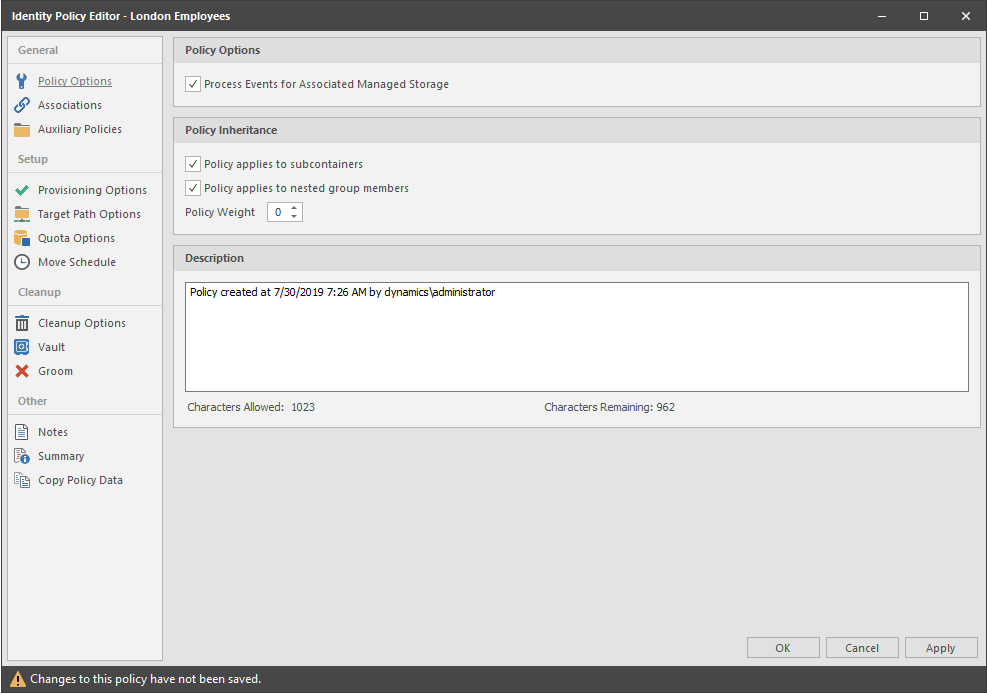
-
Set the Policy Options specifications for the policy:
-
If you want the container’s subcontainers to inherit the policy settings, leave the Policy applies to subcontainers check box selected. Otherwise, deselect it.
-
If you will have users that are members of multiple groups, which means they could be affected by multiple policies, use the Policy Weight field to indicate a weight for this policy.
When multiple policies pertain to a user, File Dynamics uses the highest weight number to determine which policy to apply.
-
Click Apply to save your settings.
-
-
Set the associations:
-
In the left pane, click Associations.
-
Click Add.
-
Browse to and locate the domain, organizational unit, Group object, or User object you want the policy applied to, then drag it to the Selected Object pane.
-
Click Apply to save the settings.
-
-
Set the provisioning specifications:
-
Click Provisioning Options.
-
In the Folder Properties region, specify the settings to be for the permissions you want applied to network home folders that are created through this policy.
-
In the Template Folder region, click the Browse button to locate and place a path to a template directory that can be copied into each home folder.
For more information on templates, see Section 6.5.3, Setting Provisioning Options.
-
In the Home Folder Options region, indicate the network drive letter to assign to your users.
-
Click Apply to save the settings.
-
-
Set the target paths:
-
In the left pane, click Target Path Options.
-
Click Add, browse to the share where you want your home folders to reside, right-click and choose Select to add the target path to the Selected Paths pane.
-
If you want to set the location of home folders among different paths, repeat Step 8.b to include all the paths you want.
-
If you have multiple paths listed, select a distribution method from the Distribution drop-down list.
For an explanation of storage distribution, see Section 6.5.4, Setting Target Paths.
-
Leave the other fields as they are currently set.
-
Click Apply to save your settings.
-
-
Set the quota options:
-
In the left pane, click Quota Options.
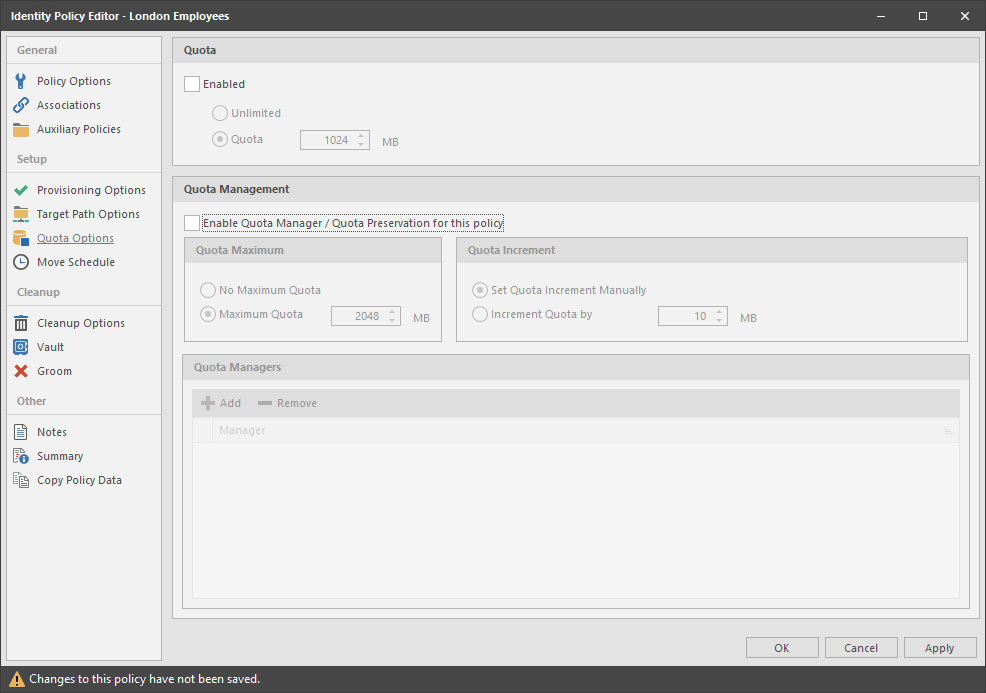
-
In the Quota region, click Enabled and specify the amount of initial storage space to be allocated to all users associated with this policy.
-
In the Quota Management region, click the Enable Quota Manager / Quota Preservation for this Policy check box, to display additional options.
-
Select one of the following Quota Maximum options:
-
Use the No Maximum Quota option to specify that the users managed by this policy will be granted additional storage quota when they need more.
-
Use the Maximum Quota field to specify the maximum amount of storage that is allocated to a user. This allocation comes through the quota increment settings below.
-
-
Select one of the following Quota Increment options:
-
Select the Set Quota Increment Manually option to allow users who are designated as quota managers to set quotas manually.
-
Select the Increment quota by option to indicate the size in MB for each new allocation of additional storage quota.
-
-
In the Quota Managers region, click Add and specify users who will serve as quota managers.
-
Click Apply to save your settings.
-
-
Set the move schedule:
-
In the left pane, click Move Schedule.
-
Specify the hours when File Dynamics can perform data migrations.
For more information on movement of data between multiple policy paths, see Section 6.5.6, Setting the Move Schedule.
-
Click Apply to save the settings.
-
-
Set the cleanup options:
-
In the left pane, click Cleanup Options.
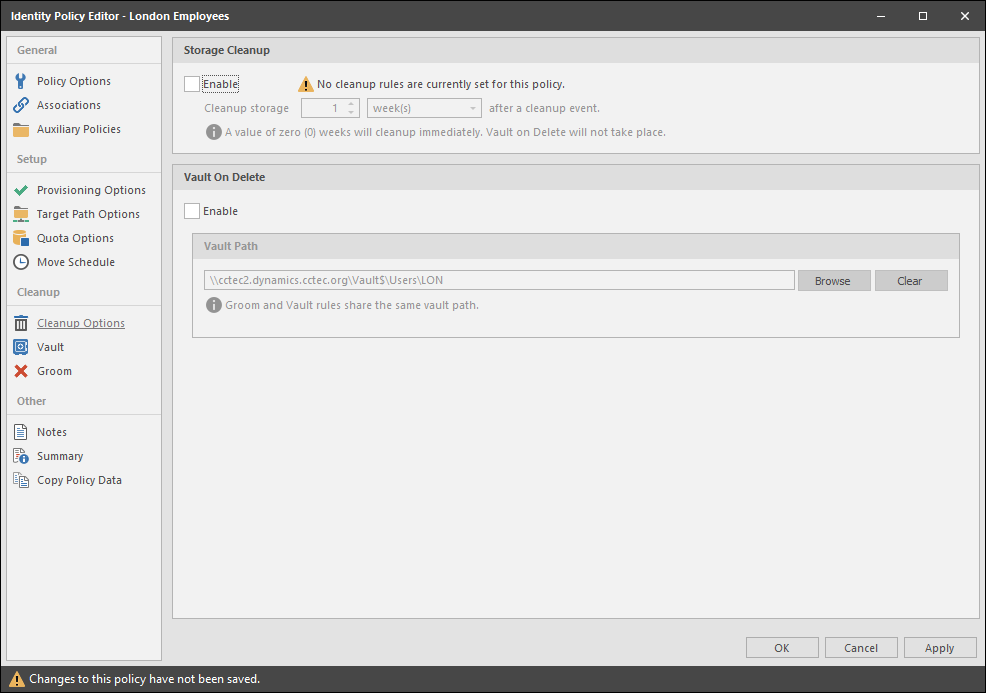
-
In the Storage Cleanup region, select the Enable check box to indicate if you want user storage associated with this policy deleted when a user is removed from Active Directory.
If you select the check box, you can specify the number of days a user home folder and its contents will remain before it is deleted.
-
If you want user storage associated with this policy vaulted, in the Vault on Delete region, select the Enable check box and use the Browse button to indicate a path to the vault location.
-
Click Apply to save your settings.
If you have both Storage Cleanup and Vault on Delete enabled, File Dynamics vaults the data and then deletes it after the specified period of time. If you have Vault on Delete but not Storage Cleanup enabled, File Dynamics vaults the data immediately and never cleans it up.
-
-
Set the vault rules:
-
In the left pane, click Vault.
-
Click Add to create vault rules.

For example, in the rule above, all .tmp files are deleted prior to their home folder being vaulted. When the specified number of days in the Cleanup storage after field has passed, the home folder is deleted from the specified vault location.
-
Click Apply to save your settings.
-
-
Set the groom rules:
-
In the left pane, click Groom.
-
Click Add.
This brings up the Rule Editor dialog box.
-
Select either Vault, Delete, or Ignore from the Action drop-down menu to specify whether to vault, delete, or ignore files or folders.
-
In the File Name Mask field, indicate the type of file or the name of a folder for which this groom rule will take action. For example, *.mp3 and *.mp4.
If you choose to vault files, you must have a specified vault path in the Vault Path field of the Vault Rules page.
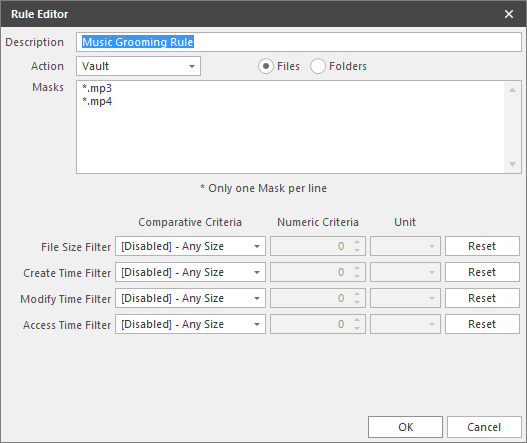
To narrow the scope of the groom rule, you can use the filter settings in the lower portion of the dialog box.
For example, if you select Greater than from the File Size Filter drop-down menu, enter 2 as the Numeric Criteria, and select MBs as the Unit setting, the groom rule in this example vaults all MP3 and MP4 files greater than 2 MB. Setting additional filters narrows the scope of the grooming action even more.
-
Click OK to save the groom rule.
-
Repeat Step 13.a through Step 13.e to create additional groom rules.
-
Click Apply to apply the groom rules.
-
-
Click OK to save the policy settings.